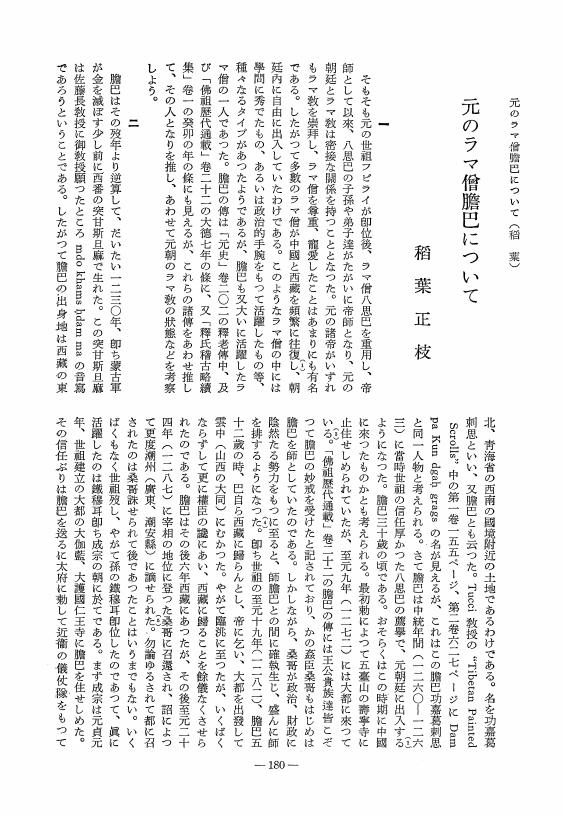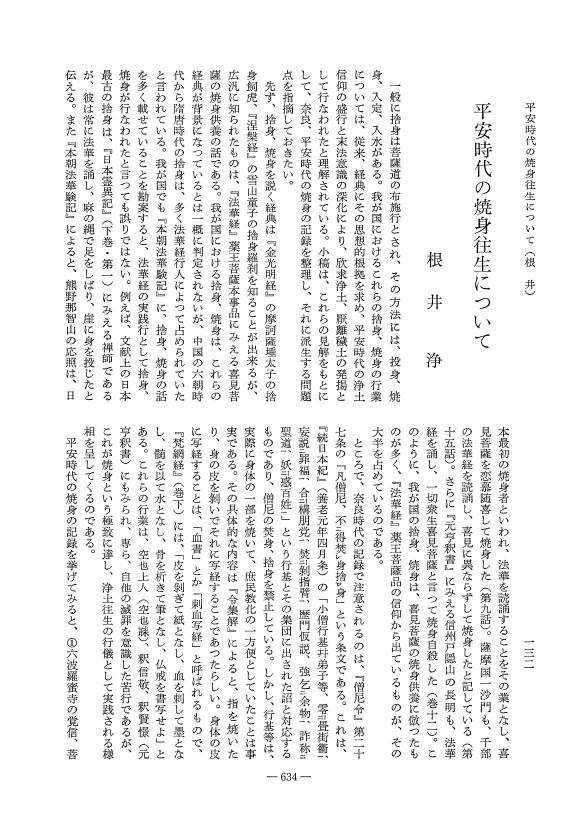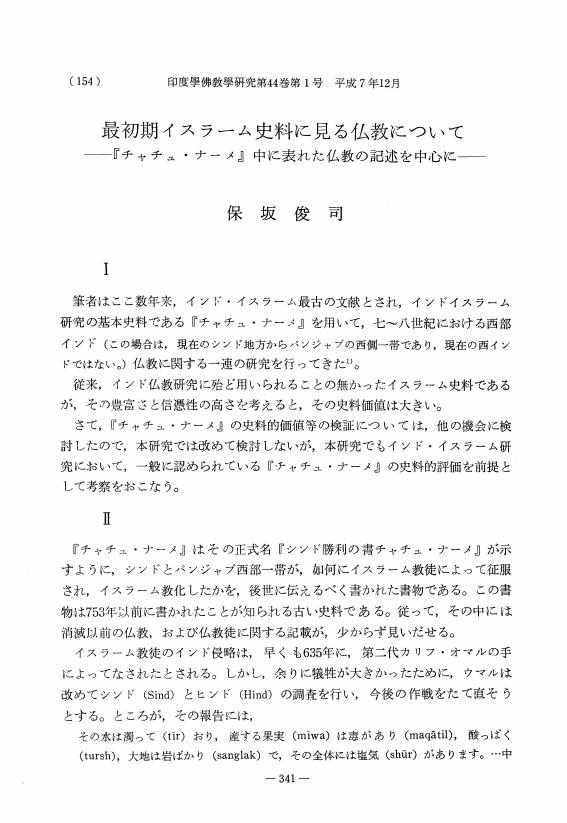14 0 0 0 OA 元のラマ僧膽巴について
- 著者
- 稻葉 正枝
- 出版者
- JAPANESE ASSOCIATION OF INDIAN AND BUDDHIST STUDIES
- 雑誌
- 印度學佛教學研究 (ISSN:00194344)
- 巻号頁・発行日
- vol.11, no.1, pp.180-182, 1963-01-15 (Released:2011-06-08)
- 著者
- 坂輪 宣政
- 出版者
- 日本印度学仏教学会
- 雑誌
- 印度学仏教学研究 (ISSN:00194344)
- 巻号頁・発行日
- vol.54, no.2, pp.804-807, 2006-03
11 0 0 0 OA 宝唱『名僧伝』に見られる「師」・「苦節」の区別について
- 著者
- 李 尚曄
- 出版者
- 日本印度学仏教学会
- 雑誌
- 印度學佛教學研究 (ISSN:00194344)
- 巻号頁・発行日
- vol.69, no.2, pp.789-786, 2021-03-25 (Released:2021-09-06)
- 参考文献数
- 4
By utilizing previous studies that have identified the biographies of the monks included in the now-lost Mingseng zhuan 名僧伝 from the Gaoseng zhuan 高僧伝, this paper analyzes the uneven distribution of social traits among the monks who were categorized as “shi” 師 and “kujie” 苦節 in the Mingseng zhuan, and proposes the possibility that Baochang’s use of the dual categories of “shi” and “kujie” in the Mingseng zhuan reflected the dualistic class structure of the early medieval Chinese saṃgha.
11 0 0 0 OA 僧と陰陽師
- 著者
- 木場 明志
- 出版者
- Japanese Association of Indian and Buddhist Studies
- 雑誌
- 印度學佛教學研究 (ISSN:00194344)
- 巻号頁・発行日
- vol.26, no.2, pp.757-760, 1978-03-20 (Released:2010-03-09)
11 0 0 0 唐初期三一権実論争の起因に対する論争当事者の認識
- 著者
- 小野嶋 祥雄
- 出版者
- 日本印度学仏教学会
- 雑誌
- 印度學佛教學研究 (ISSN:00194344)
- 巻号頁・発行日
- vol.63, no.2, pp.752-756, 2015
10 0 0 0 色(rupa)は物質ではない:――仏典における原意と訳語の考察――
- 著者
- 村上 真完
- 出版者
- 日本印度学仏教学会
- 雑誌
- 印度學佛教學研究 (ISSN:00194344)
- 巻号頁・発行日
- vol.59, no.2, pp.858-851, 2011
9 0 0 0 OA 平安時代の焼身往生について
- 著者
- 根井 浄
- 出版者
- Japanese Association of Indian and Buddhist Studies
- 雑誌
- 印度學佛教學研究 (ISSN:00194344)
- 巻号頁・発行日
- vol.27, no.2, pp.634-635, 1979-03-31 (Released:2010-03-09)
9 0 0 0 OA 善導の在家弟子に見る臨終行儀――新出「念弥陀仏誦弥陀経行者」墓誌銘について――
- 著者
- 倉本 尚徳
- 出版者
- 日本印度学仏教学会
- 雑誌
- 印度學佛教學研究 (ISSN:00194344)
- 巻号頁・発行日
- vol.70, no.1, pp.67-73, 2021-12-20 (Released:2022-09-09)
- 参考文献数
- 7
This paper presents the original text and a modern Japanese translation of an epitaph for the Tang period lay person Bao Baoshou 包宝寿, and then examines connections between Shandaoʼs 善導 writings and the epitaphʼs portrayal of daily life practices for Pure Land rebirth and deathbed rites. The former consist of being mindful of Amitābha Buddha, reciting the Amituo jing, and maintaining the abstinential rules. The daily life practices for rebirth and the signs of the coming of the holy retinue to welcome him to the Pure Land experienced by Bao at the end of his life can be seen as the “highest of the high stage” (shangpin shangsheng 上品上生) as described in the Pure Land Contemplation Sūtra 観無量寿経, and also match the practice for the “highest of the high stage” in the Guannian famen 観念法門. Many lay practitioners were present at the end of Baoʼs life and Shandao also emphasized the existence of fellow practitioners.
- 著者
- 下田 正弘
- 出版者
- 日本印度学仏教学会
- 雑誌
- 印度學佛教學研究 (ISSN:00194344)
- 巻号頁・発行日
- vol.68, no.2, pp.1043-1035, 2020-03-20 (Released:2020-09-10)
- 参考文献数
- 19
More than fifteen years ago, Schopen (2004, 492) revealed his concern about a certain understanding widespread among scholars of the history of Indian Buddhism, writing, “[t]he historical development of Indian Buddhism used to be presented as simple, straightforward, and suspiciously linear. It started with the historical Buddha whose teaching was organized, transmitted, and more or less developed into what was referred to as early Buddhism. This Early Buddhism was identified as Hīnayāna ... , Theravāda ... , or simply ‘monastic Buddhism.’ ... A little before or a little after the beginning of the common era this early Buddhism was, according to the model, followed by the Mahāyāna ... ” A similar apprehension has recently been expressed in slightly different terms by Harrison (2018, 8–9). It is certainly surprising that scholars’ basic frame of reference for the history of Indian Buddhism is more or less what it was in the late 19th century, despite all of the progress recently made in this field. Developments in the particulars of the subfields of Indian Buddhist history have not entailed comparable developments in the broader frame of reference, despite the fact that such a frame is what allows us to identify and synthesize the details of our field. This paper attempts to address this problem by focusing on three points: first, it reexamines the current state of affairs of materials for the reconstruction of the history of ancient India; second, it reevaluates the status of Pāli materials as historical sources; and third, it reconsiders the concept of ‘canon’ in Buddhist studies.
9 0 0 0 OA 日本梵字弥陀名号の研究
- 著者
- 斎藤 彦松
- 出版者
- Japanese Association of Indian and Buddhist Studies
- 雑誌
- 印度學佛教學研究 (ISSN:00194344)
- 巻号頁・発行日
- vol.36, no.1, pp.260-263, 1987-12-25 (Released:2010-03-09)
9 0 0 0 OA 梵字勃〓〓 Bhrum 信仰の研究
- 著者
- 齋藤 彦松
- 出版者
- Japanese Association of Indian and Buddhist Studies
- 雑誌
- 印度學佛教學研究 (ISSN:00194344)
- 巻号頁・発行日
- vol.28, no.2, pp.837-840, 1980-03-31 (Released:2010-03-09)
8 0 0 0 OA 下田正弘とグレゴリー・ショペン : 大乗仏教の起源をめぐって
- 著者
- 佐々木 閑
- 出版者
- 日本印度学仏教学会
- 雑誌
- 印度學佛教學研究 (ISSN:00194344)
- 巻号頁・発行日
- vol.61, no.1, pp.342-334, 2012-12-20
7 0 0 0 OA 釈道安の長安移住年次の再考――「比丘大戒序」等に見える木星紀年法の分析を通して――
- 著者
- 李 尚曄
- 出版者
- 日本印度学仏教学会
- 雑誌
- 印度學佛教學研究 (ISSN:00194344)
- 巻号頁・発行日
- vol.71, no.2, pp.750-746, 2023-03-22 (Released:2023-09-08)
- 参考文献数
- 13
Dao’an’s 道安 (314-385 CE) relocation to Chang’an is an important historical event that marked the revival of translation activities among Buddhists in early medieval China. Earlier scholars such as Tang Yongtong, Erik Zürcher, and Ui Hakuju assumed that Dao’an’s relocation to Chang’an took place in the year 379. However, this hypothesis does not take into account the Jovian years recorded in the documents produced by Dao’an’s translation team in Chang’an. In this paper, by making use of such resources as the astronomy simulation software Stellarium, I show that the Jovian years recorded in the Dao’an team’s documents match the actual locations of Jupiter of the time, and argue that Dao’an’s relocation to Chang’an must have taken place in 378 rather than in 379.
7 0 0 0 OA インド密教における護摩儀礼の展開
- 著者
- 森 雅秀
- 出版者
- Japanese Association of Indian and Buddhist Studies
- 雑誌
- 印度學佛教學研究 (ISSN:00194344)
- 巻号頁・発行日
- vol.42, no.1, pp.420-412, 1993-12-25 (Released:2010-03-09)
- 参考文献数
- 18
- 被引用文献数
- 1
7 0 0 0 OA 『大目乾連冥間救母変文』における救済方法の考察
- 著者
- 筑後 誠邦
- 出版者
- 日本印度学仏教学会
- 雑誌
- 印度學佛教學研究 (ISSN:00194344)
- 巻号頁・発行日
- vol.57, no.1, pp.99-102, 2008-12-20 (Released:2017-09-01)
7 0 0 0 OA 日本で発見されたオリヤー語の『マハーバーラタ』について
- 著者
- Shobha Rani DASH
- 出版者
- Japanese Association of Indian and Buddhist Studies
- 雑誌
- 印度學佛教學研究 (ISSN:00194344)
- 巻号頁・発行日
- vol.54, no.2, pp.872-869,1324, 2006-03-20 (Released:2010-07-01)
A palm leaf manuscript of the Oriya Mahabharata written by the famous Oriya poet Sudramuni Srisaraladasa of the mid 15th c. was transmitted to Tsusima-cho of Ehime prefecture in Japan during the 18th century A. D. It ia ssumed that the manuscript was transcribed in the beginning of the 17th c. It was written in the medieval Oriya language using the medieval Oriya script except the invocation to Lord Ganesa, which is in Sanskrit. It consists of 221 leaves (transcribed on both sides), a few blank leaves and a bamboo cover. In the beginning and the end of the manuscript it mentions clearly that it is the first part of the Aranyakaparba of the Mahabharata. It is a typical manuscript of Orissa, an Eastern state in India. The most interesting point to note is that it is not just an Oriya translation of the Sanskrit Mahabharata, but is an Oriya version of it. Since 2001, I have been working on its romanized edition and Japanese translation along with Mr. Nobuyuki Kashiwahara and Prof. Hojun Nagasaki as the chief. A new relationship between Orissa and Japan is expected to be explored from the research of this manuscript.
7 0 0 0 如来蔵思想は仏教にあらず
- 著者
- 松本 史朗
- 出版者
- 日本印度学仏教学会
- 雑誌
- 印度學佛教學研究 (ISSN:00194344)
- 巻号頁・発行日
- vol.35, no.1, pp.375-370, 1986
- 著者
- 宮本 正尊
- 出版者
- JAPANESE ASSOCIATION OF INDIAN AND BUDDHIST STUDIES
- 雑誌
- 印度學佛教學研究 (ISSN:00194344)
- 巻号頁・発行日
- vol.13, no.2, pp.855-845, 1965-03-31 (Released:2010-03-09)
7 0 0 0 ジャムヤン・シェーパのチベット仏教史年表
- 著者
- 西岡 祖秀
- 出版者
- JAPANESE ASSOCIATION OF INDIAN AND BUDDHIST STUDIES
- 雑誌
- 印度學佛教學研究 (ISSN:00194344)
- 巻号頁・発行日
- vol.54, no.1, pp.497-493,1285, 2005
The Chronological Table of Tibetan Buddhist history of 'Jam-dbyangs-bzhad-pa precedes the famous chronological table of Sum-pa-mkhan-po. A feature of both chronological tables is that they were written in acceptance of the legend of the country of Shambhala, as taught in the <i>Kalacakratantra</i>. Namely, they record that the 25th generation Raudracakrin king of the ideal Buddhism kingdom Shambhala will win the final war with Islam, reviving Buddhism. Sum-pa-mkhan-po projects the date of this event to be A. D. 2376.
- 著者
- 保坂 俊司
- 出版者
- JAPANESE ASSOCIATION OF INDIAN AND BUDDHIST STUDIES
- 雑誌
- 印度學佛教學研究 (ISSN:00194344)
- 巻号頁・発行日
- vol.44, no.1, pp.341-338, 1995-12-20 (Released:2010-03-09)









